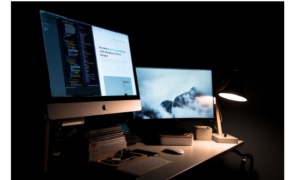Are you ready to revolutionize your website and take it to the next level? Say hello to 3D web design, the cutting-edge trend that’s transforming online experiences like never before. Gone are the days of flat and mundane websites; it’s time to embark on a journey into new dimensions with eye-popping visuals, immersive interactions, and captivating user experiences. In this blog post, we’ll dive deep into the world of 3D web design, exploring its endless possibilities and revealing how it can elevate your online presence from ordinary to extraordinary.
Introduction to 3D Web Design
In recent years, the world of web design has taken a huge leap forward with the introduction of 3D technology. This innovative approach to web design has completely transformed traditional flat and static websites into dynamic and immersive experiences. With 3D web design, websites are no longer limited to just two dimensions but can now incorporate depth, texture, and movement.
So what exactly is 3D web design? It is a technique that uses three-dimensional models, animations, and interactive elements to create a more realistic and engaging website. It involves using specialized software, such as WebGL or Unity, to bring these elements to life on a webpage.
The rise of virtual reality (VR) and augmented reality (AR) technologies has also contributed greatly to the popularity of 3D web design. These futuristic technologies allow users to fully immerse themselves in a digital environment, which makes for an unforgettable online experience.
Now you may be wondering why your website needs this type of design. The answer is simple: it provides a whole new level of interactivity for your audience. Instead of just scrolling through text and images on a screen, users can now interact with objects in a virtual space. This not only enhances user engagement but also creates a memorable experience that will set your website apart from others.
What is 3D web design?
3D web design is a relatively new and innovative approach to website development that involves the use of three-dimensional elements, animations, and virtual environments to create an immersive user experience. With the advancement of technology, 3D web design has become increasingly popular in recent years as it allows for more visually appealing and engaging websites.
In traditional 2D web design, websites are created with flat images and text on a two-dimensional plane. However, with 3D web design, designers can add depth and dimension to their creations by incorporating realistic textures, shadows, and even interactive elements. This creates a more dynamic and lifelike experience for users as they navigate through the website.
One of the main advantages of using 3D elements in web design is the ability to showcase products or services in a more realistic manner. For businesses that rely heavily on visual representation, such as interior designers or architects, showcasing their work through 3D web design can be incredibly beneficial. It allows potential clients to get a better understanding of what they have to offer before making any commitments.
The importance of 3D in web design
The use of 3D elements in web design has become increasingly popular in recent years, and for good reason. These three-dimensional graphics can add a whole new level of depth and engagement to your website, creating a more immersive user experience. In this section, we will delve into the importance of using 3D in web design and how it can take your website to new dimensions.
1. Increases visual appeal:
One of the main reasons why 3D has gained popularity is due to its ability to make websites visually appealing. 3D elements such as animations, graphics, and interactive features can capture the attention of visitors immediately and keep them engaged with your website for longer periods of time. This not only creates a positive first impression but also increases the chances of converting visitors into leads or customers.
2. Improves user engagement:
In today’s fast-paced digital world, users expect more from websites than just static images and text. By incorporating 3D elements into your web design, you provide users with an interactive experience that encourages them to explore and engage with your site. This can include features like 360-degree product views or virtual tours that allow users to interact with your products or services in a more dynamic way.
3. Enhances brand image:
Using 3D elements in web design can also help enhance your brand image by making it stand out from competitors’ websites. It allows you to showcase your brand’s unique personality and style through innovative design techniques that are not possible with traditional two-dimensional designs.
4. Tells a Story:
Incorporating 3D elements into web design also opens up endless possibilities for storytelling on your website. With the use of animations, videos, and other visual effects, you can effectively convey complex ideas or messages in an engaging manner that captures the attention of users.
5. Boosts SEO:
Another often overlooked benefit of using 3D in web design is its impact on search engine optimization (SEO). By adding 3D elements to your website, you can significantly increase the time visitors spend on your site, reduce bounce rates, and improve overall user engagement. These factors are crucial for SEO, as they indicate to search engines that your website is relevant and provides value to users.
The importance of using 3D in web design cannot be overemphasized enough. It not only adds a visual wow factor but also enhances user engagement, helps build brand image, allows for storytelling, and boosts SEO. Incorporating 3D elements into your website can truly take it to new dimensions and give you a competitive edge in today’s digital landscape.
Benefits of Using 3D in Website Design
1. Enhanced Visual Appeal: One of the key benefits of using 3D in website design is that it instantly enhances the visual appeal of your website. The use of three-dimensional elements, such as images, graphics, and animations, adds depth and dimension to your site, making it more engaging and visually appealing to users.
2. Improved User Experience: With 3D design techniques, you can create a more interactive and immersive experience for your website visitors. By incorporating 3D elements into your design, you can provide users with a sense of control and interactivity as they navigate through your site. This can ultimately lead to increased user engagement and satisfaction.
3. Differentiation from Competitors: In today’s competitive digital landscape, having a unique and eye-catching website is crucial for standing out from the crowd. Incorporating 3D elements into your website design can help differentiate your brand from competitors who may be using traditional two-dimensional designs.
4. Stronger Brand Image: By incorporating 3D elements that align with your brand identity into your web design, you can strengthen your brand image and make a lasting impression on visitors. A well-designed 3D website can give off a modern, cutting-edge vibe that reflects positively on your brand’s image.
5. Greater Flexibility in Design: The use of three-dimensional elements in web design also offers greater flexibility in terms of creativity and customization options compared to traditional flat designs. With advanced software tools available for creating 3D visuals, designers have the freedom to bring their creative visions to life without being limited by technical constraints.
6. Better Storytelling Opportunities: Three-dimensional visuals are excellent storytelling tools as they allow designers to incorporate dynamic movements and perspectives into their designs. This gives them the ability to tell stories or showcase products or services in a more compelling way than static images or text alone.
7. Increased Conversions: By providing a more immersive and interactive experience for users, 3D website design has the potential to increase conversions and drive sales. The engaging nature of 3D elements can capture the attention of users and hold it long enough to make them take action, whether it be making a purchase or filling out a form.
Incorporating 3D elements into your website design can bring numerous benefits that enhance the user experience, strengthen brand image, and ultimately lead to greater success online. It is an innovative way to elevate your website to new dimensions and stand out in the digital landscape.
Examples of Websites with 3D Design
There are countless websites on the internet that have embraced 3D design, bringing a whole new level of creativity and innovation to their online presence. In this section, we will take a closer look at some of the best examples of websites with 3D design.
1. Apple
Apple is known for its sleek and modern designs, and their website is no exception. The use of 3D elements adds depth and sophistication to the overall look and feel of the site. From product showcases to interactive animations, Apple’s website truly takes advantage of 3D design to engage its audience in a visually stunning way.
2. Nike
The popular sportswear brand Nike has also incorporated 3D design into their website. Their homepage features an interactive shoe display where users can rotate and zoom in on different shoes to view them from all angles. This not only allows for a more immersive experience, but also gives customers a better understanding of the products they are interested in purchasing.
3. Airbnb
Airbnb’s website utilizes 3D design in a unique way by creating an interactive map that showcases all available rental properties around the world. Users can zoom in on specific locations and see individual listings pop up with photos and information about each property. This not only makes for an engaging user experience but also helps users visualize their potential vacation plans.
Conclusion
Web design is constantly evolving, and 3D design has become a popular trend in recent years. These examples demonstrate the potential of 3D design to elevate a website’s visual appeal and engage users in new and exciting ways. Whether it’s through interactive product displays, immersive animations, or unique user interfaces, 3D design can bring a whole new level of creativity and innovation to any website. As technology continues to advance, we can expect to see even more stunning examples of websites with 3D design in the future.


































